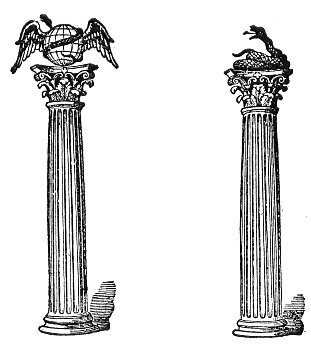Isis, during the absence of Osiris, and after she had hidden the coffer in the place where Typhon found it, had rejoined that malignant enemy; indignant at which, Horns her son deprived her of her ancient diadem, when she rejoined Osiris as he was about to attack Typhon: but Mercury gave her in its place a helmet shaped like the head of a bull. Then Horus, as a mighty warrior, such as Orion was described, fought with and defeated Typhon; who, in the shape of the Serpent or Dragon of the Pole, had assailed his father. So, in Ovid, Apollo destroys the same Python, when Io, fascinated by Jupiter, is metamorphosed into a cow, and placed in the sign of the Celestial Bull, where she becomes Isis. The equinoctial
p. 483
year ends at the moment when the Sun and Moon, at the Vernal Equinox, are united with Orion, the Star of Horus, placed in the Heavens under Taurus. The new Moon becomes young again in Taurus, and shows herself as a crescent, for the first time, in the next sign, Gemini, the domicile of Mercury. Then Orion, in conjunction with the Sun, with whom he rises, precipitates the Scorpion, his rival, into the shades of night, causing him to set whenever he himself reappears on the eastern horizon, with the Sun. Day lengthens and the germs of evil are by degrees eradicated: and Horus (from Aur, Light) reigns triumphant, symbolizing, by his succession to the characteristics of Osiris, the eternal renewal of the Sun’s youth and creative vigor at the Vernal Equinox.
Such are the coincidences of astronomical phenomena with the legend of Osiris and Isis; sufficing to show the origin of the legend, overloaded as it became at length with all the ornamentation natural to the poetical and figurative genius of the Orient.
Not only into this legend, but into those of all the ancient nations, enter the Bull, the Lamb, the Lion, and the Scorpion or the Serpent; and traces of the worship of the Sun yet linger in all religions. Everywhere, even in our Order, survive the equinoctial and solstitial feasts. Our ceilings still glitter with the greater and lesser luminaries of the Heavens, and our lights, in their number and arrangement, have astronomical references. In all churches and chapels, as in all Pagan temples and pagodas, the altar is in the East; and the ivy over the east windows of old churches is the Hedera Helix of Bacchus. Even the cross had an astronomical origin; and our Lodges are full of the ancient symbols.
The learned author of the Sabæan Researches, Landseer, advances another theory in regard to the legend of Osiris; in which he makes the constellation Boötes play a leading part. He observes that, as none of the stars were visible at the same time with the Sun, his actual place in the Zodiac, at any given time, could only be ascertained by the Sabæan astronomers by their observations of the stars, and of their heliacal and achronical risings and settings. There were many solar festivals among the Sabæans, and part of them agricultural ones; and the concomitant signs of those festivals were the risings and settings of the stars of the Husbandman, Bear-driver, or Hunter, BOÖTES. His stars were,
p. 484
among the Hierophants, the established nocturnal indices or signs of the Sun’s place in the ecliptic at different seasons of the year, and the festivals were named, one, that of the Aphanism or disappearance; another, that of the Zetesis, or search, etc., of Osiris or Adonis, that is, of Boötes.
The returns of certain stars, as connected with their concomitant seasons of spring (or seed-time) and harvest, seemed to the ancients, who had not yet discovered that gradual change, resulting from the apparent movement of the stars in longitude, which has been termed the precession of the equinoxes, to be eternal and immutable; and those periodical returns were to the initiated, even more than to the vulgar, celestial oracles, announcing the approach of those important changes, upon which the prosperity, and even the very existence of man must ever depend; and the oldest of the Sabæan constellations seem to have been, an astronomical Priest, a King, a Queen, a Husbandman, and a Warrior; and these more frequently recur on the Sabæan cylinders than any other constellations whatever. The King was Cepheus or Chepheus of Ethiopia: the Husbandman, Osiris, Bacchus, Sabazeus, Noah or Boötes. To the latter sign, the Egyptians were nationally, traditionally and habitually grateful; for they conceived that from Osiris all the greatest of terrestrial enjoyments were derived. The stars of the Husbandman were the signal for those successive agricultural labors on which the annual produce of the soil depended; and they came in consequence to be considered and hailed, in Egypt and Ethiopia, as the genial stars of terrestrial productiveness; to which the oblations, prayers, and vows of the pious Sabæan were regularly offered up.

Moe is the founder of GnosticWarrior.com. He is a father, husband, author, martial arts black belt, and an expert in Gnosticism, the occult, and esotericism.






